Final Report for FS16-291
Project Information
During the 2016 growing season Common Wealth Seed Growers conducted winter squash research that included a variety trial of 23 seedstocks; three selection projects ('Seminole Pumpkin,' 'Chinese Tropical Pumpkin' and 'Cuban Neck Pumpkin’); and a breeding trial with F5 seeds from a cross of 'Seminole Pumpkin' and 'Waltham Butternut.'
Winter Squash Variety Trial, August 2016
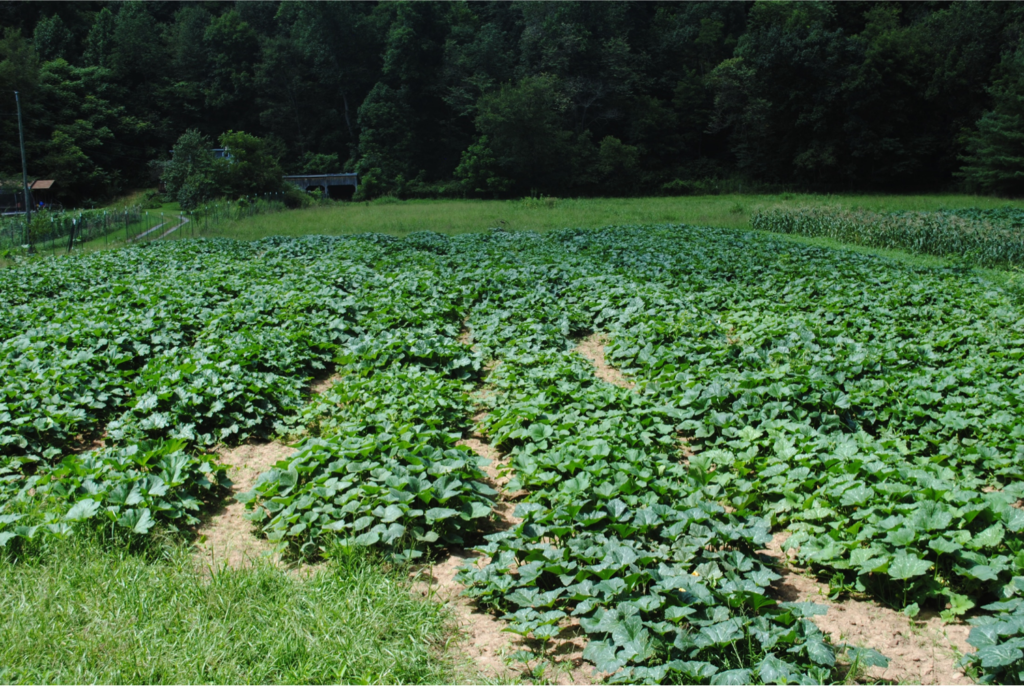
Common Wealth Seed Growers is a Virginia seed company started in 2014 to promote regional seed system development through research, education, seed production, plant breeding and selection.
Introduction
The goal of this project is to identify and develop high quality Cucurbita moschata (winter squash and tropical pumpkin) varieties that thrive under low-input, organic management in Virginia’s hot and humid conditions, especially in terms of resistance to downy mildew.
In a previous SARE-funded winter squash trialing project from 2014 (see SARE Award Number FS13-273, 'Identifying and Marketing Quality Open-Pollinated and Organic Cucurbit Seedstocks for Virginia'), Edmund Frost identified several winter squash seedstocks from the Southeast US, and several tropical pumpkin seedstocks with good downy mildew resistance. These seedstocks, however tended to have problems that included large size, large seed cavity size, poor marketability, poor eating quality, and splitting. The northern winter squash varieties entered in the trial performed poorly for downy mildew resistance.
Based on this trial, and based on conversations with winter squash producers at agriculture conferences and tradeshows throughout the Southeast and mid-Atlantic regions in 2014 and 2015, Common Wealth Seed Growers identified a need for better adapted, downy mildew-resistant, high quality winter squash varieties.
We approached the need for downy mildew-resistant and regionally adapted winter squash from two angles:
-Selection projects aimed at improving the existing varieties 'Seminole Pumpkin,' 'Chinese Tropical Pumpkin,' and 'Cuban Neck Pumpkin;' as well as a breeding trial using F5 seeds from a cross of 'Seminole Pumpkin' and 'Waltham Butternut.’ Goals included recording data on DM resistance, yield and eating quality, and identifying and saving seed from individual plants that stood out.
-A winter squash variety trial of 23 seedstocks. Goals included recording data on DM resistance, yield and eating quality; comparing the seedstocks used in the above selection projects to several commercial butternut varieties; documenting the progress in ongoing selection work with the Seminole-Waltham cross by trialing seedstocks from different generations of the cross; and evaluating new tropical pumpkin seedstocks to identify standout varieties or material useful for future breeding work.
Cooperators
Research
All plantings were fertilized with organic-approved inputs based on soil test results. Plantings at Sycamore Farm were fertilized with chicken manure at approx. 3 tons per acre, and later side dressed with potassium sulfate, rock phosphate and granulated chicken manure fertilizer. Chinese Tropical Pumpkin (at Twin Oaks Seed Farm) was fertilized using tofu okara at approx. 5 tons per acre. Cuban Neck Pumpkin (grown by Lyndsey Walker) was fertilized using chicken manure at approx. 4 tons per acre.
The Cuban Neck Pumpkin planting was unirrigated, and was managed using organic methods though not on certified organic land. All other plantings used drip irrigation, and took place on certified organic farms.
Seminole-Waltham Breeding Trial, July 7th
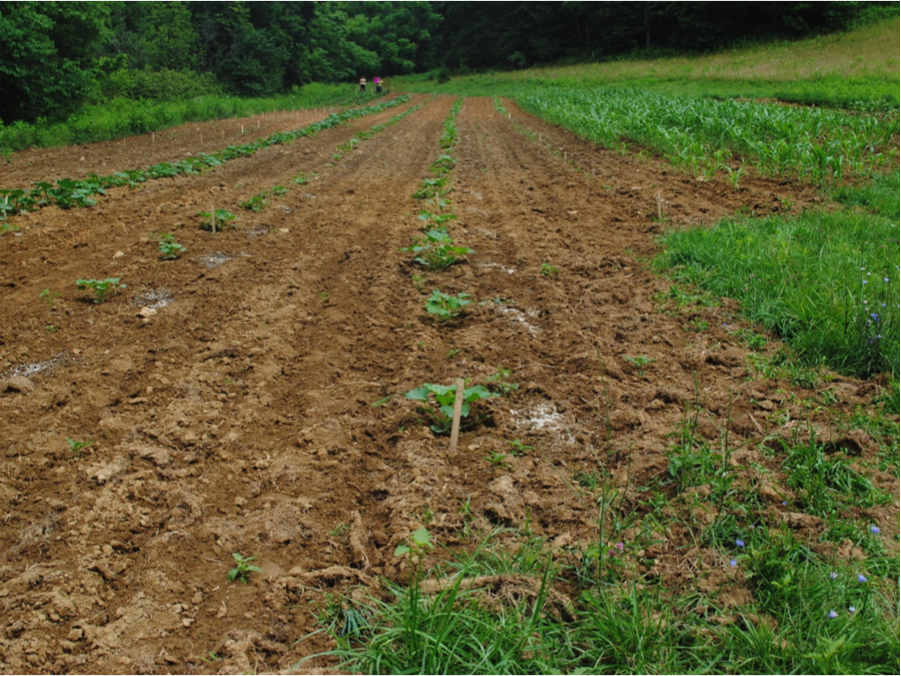
The Seminole-Waltham F5 selection project took place at Sycamore Farm (managed by Edmund Frost and Sapphyre Miria, and certified organic by Baystate) in Rockbridge County, Virginia. The planting included 108 plants at 9 foot row spacing and 8 foot in-row spacing. Eighty-nine of the plants were sown on June 8th. These seeds came from six F4 plants selected by Edmund Frost in a 2015 selection project at Twin Oaks Seed Farm.
The remaining 19 plants were sown on June 25. These came from seed of two top selections made in 2015 that were crossed together over the winter of 2015-2016 at NC A&T University by Dr. Sanjun Gu in a greenhouse. Seed was not yet ready for the June 8th planting date.
All 108 plants were trained separately from each other (1-2 times per week during peak growth) and evaluated separately. Almost all were successfully self pollinated. The planting was isolated from other C. moschata plantings so that open-crossed seed could also be saved.
An additional border row on the western edge was included to reduce variation in downy mildew pressure throughout the plants being evaluated.
All plants were evaluated for downy mildew resistance and productivity. The approximate area each plant took up was measured, in order to calculate yield per square foot as well as per plant yield. Fruits from the best 44 plants in these evaluations were then tested for brix and dry matter, and screened for flavor.
Seminole-Waltham Breeding Trial, September 26th

The Seminole Pumpkin selection project took place at Sycamore Farm in Rockbridge County, Virginia, and included 42 plants at 9 foot row spacing and 8 foot in-row spacing. Planting date was June 10th. All plants were trained separately from each other and evaluated separately. Almost all were successfully self pollinated. The planting was done in a larger field surrounded by other C. moschata varieties, so it was not possible to save open-crossed seed.
All plants were evaluated for downy mildew resistance, productivity and bacterial wilt (Bacterial wilt is rare in C. moschata, but proved to be a problem in the Seminole planting). Fruits from the best 31 plants in these evaluations were then tested for brix and dry matter, and screened for off flavors.
The Chinese Tropical Pumpkin selection project was managed by River Oneida, and took place at Twin Oaks Seed Farm (certified organic by QCS) in Louisa County, Virginia. The planting included 39 plants in two rows spaced at 9 feet, with approx. 8 feet between plants. Plants were trained separately, away from the center, and allowed to grow outward without limit. The planting was isolated from other C. moschata plantings so that open-crossed seed could be saved. Planting date was May 23rd.
All plants were evaluated for downy mildew resistance and productivity. Fruits from the best 16 plants were also evaluated for eating quality.
Chinese Tropical Pumpkin is derived from 'Crowning F1,' which is sold by Known-You Seeds of Taiwan. F2 seeds were included in Twin Oaks' 2014 trial, and did well for yield, flavor and DM resistance. Segregation was not apparent in that planting, but in 2015 and 2016 we did note segregation, indicating that 'Crowning' is indeed a hybrid, and that our work with the seedstock is a dehybridization project.
The Cuban Neck Pumpkin selection project took place at Lyndsey Walker’s farm in Buckingham County, Virginia. Forty plants were sown on May 25th in a single row, and trained separately. The planting was isolated from other C. moschata plantings so that open-crossed seed could be saved. Due to problems with the planting (see next section), fruit quality was not evaluated.
The variety trial took place at Sycamore Farm in Rockbridge County, Virginia. It included 23 entries, of which 17 were replicated (two replications) and six were unreplicated. Entries included:
- Five commercial butternut varieties: Narragansett F1, Bugle, Bellevue, Waltham and JWS 6823 PM.
- Five seedstocks from various stages of the Seminole-Waltham breeding project.
- Eight Asian tropical pumpkin seedstocks.
- Two F1 crosses made between Thai pumpkins and butternuts.
- Menina Rajada Seca (Brazil), Seminole Pumpkin, and Cuban Neck Pumpkin.
Each block included three plants spaced 2.5 feet from each other, and 12 feet from the next entry. Rows were 9 feet apart. The trial was laid out in four 200-foot rows, and bordered on all sides by buffer plantings of winter squash. Each block was trained separately, and evaluated for downy mildew resistance, brix, dry matter, yield and % marketability. The approximate area each block took up was measured, in order to calculate yield per square foot as well as per block yield.
In the Seminole-Waltham breeding trial, we found significant variation between plants in terms of downy mildew resistance, yield per plant, yield per square foot, brix and dry matter.
We were looking for plants that had high ratings in all or most of these categories, plus butternut shape. Based on field evaluations of yield and DM resistance, we identified 44 plants out of 108 to test for eating quality (using brix and dry matter tests).
Two data spreadsheets are attached. One shows DM ratings and yield calculations for all plants. Seminole-Waltham-Breeding-Trial-Field-Data-2016 The other shows all data (including eating quality) for the best 44 performers in the field. Seminole-Waltham-Eating-Quality-Data-for-Best-Selections-2016
Plants 57 and 75 were the most notable for good ratings in all categories. Plant 68 had the best DM resistance, along with good eating quality and good per-plant yield. Plant 54 had notable eating quality and yield, and moderate DM resistance. Future breeding efforts will focus on seed from these entries, and possibly from plants 29, 39, 56, 61, 63, 70, 72, 78, 80 and 108 as well (which we identified as second-tier standouts). Note that plant 72 had poor shape.
We also did a flavor screening of the best entries. Fruits from plant 62 (and no others) were identified as having off flavors.
Fruits from Seminole-Waltham Plant 68
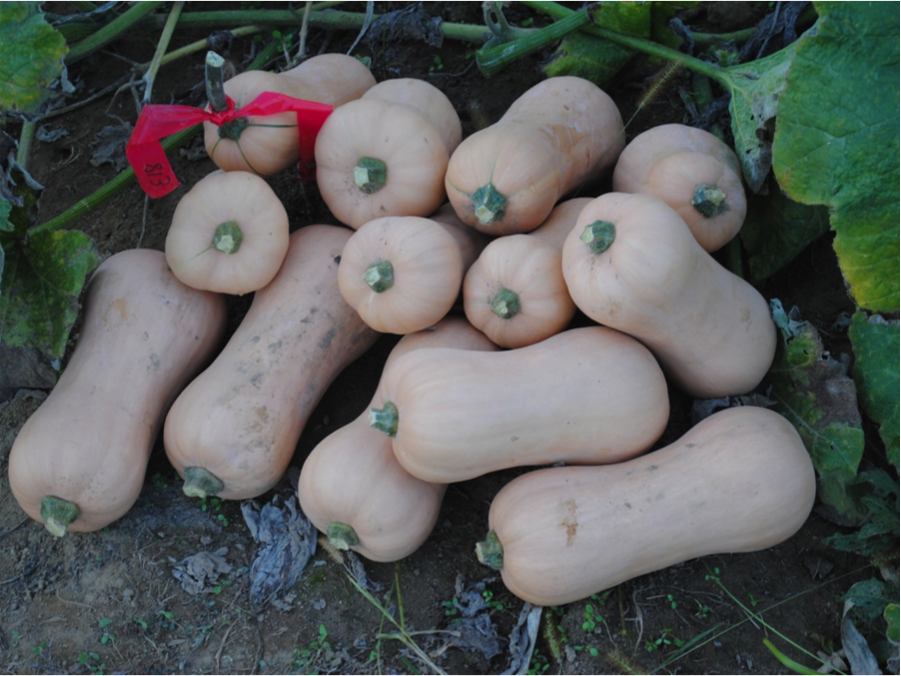
The 2016 planting included self-pollinated and open-crossed seed from 6 standout plants identified in 2015. The fruits with the best eating quality tended to come from [2015 plant 12]. Fruits with the best DM resistance tended to come from [2015 plant 5], however many of these had low or late yields, and poor eating quality. Plants from open-crossed 2015 seed tended to perform better than plants from selfed seed.
One unexpected discovery was that fruits dramatically increased in brix content between the main evaluation in early December and a second (partial) evaluation in early February. This coincides with our observation that Seminole-Waltham tends to have good keeping quality. We also did some evaluation of keeping quality among top selections in February, and are including selections in ongoing work that excelled in this category (including plants 70 and 108).
Note that plants 90-108 were planted later (June 25th) than plants 1-89 (June 8th). Plants from one group cannot be directly compared to plants from the other group for this reason. Also, since plants 90-108 were in a separate row bordering a corn planting, it was not possible to calculate area per plant, or yield per square foot.
Fruits from Seminole-Waltham Plant 75
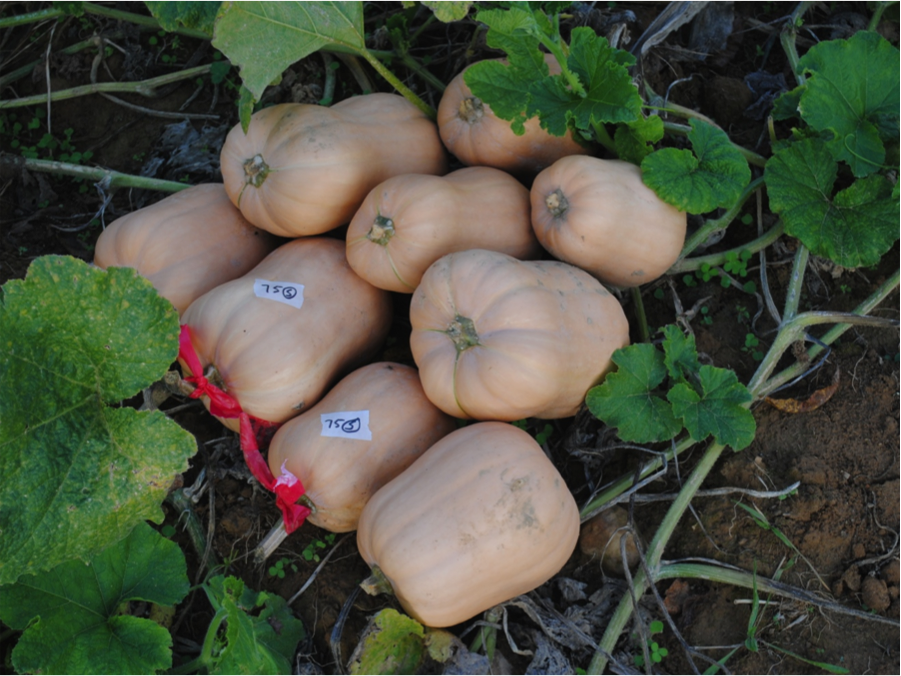
Seminole-Waltham Flavor Screening
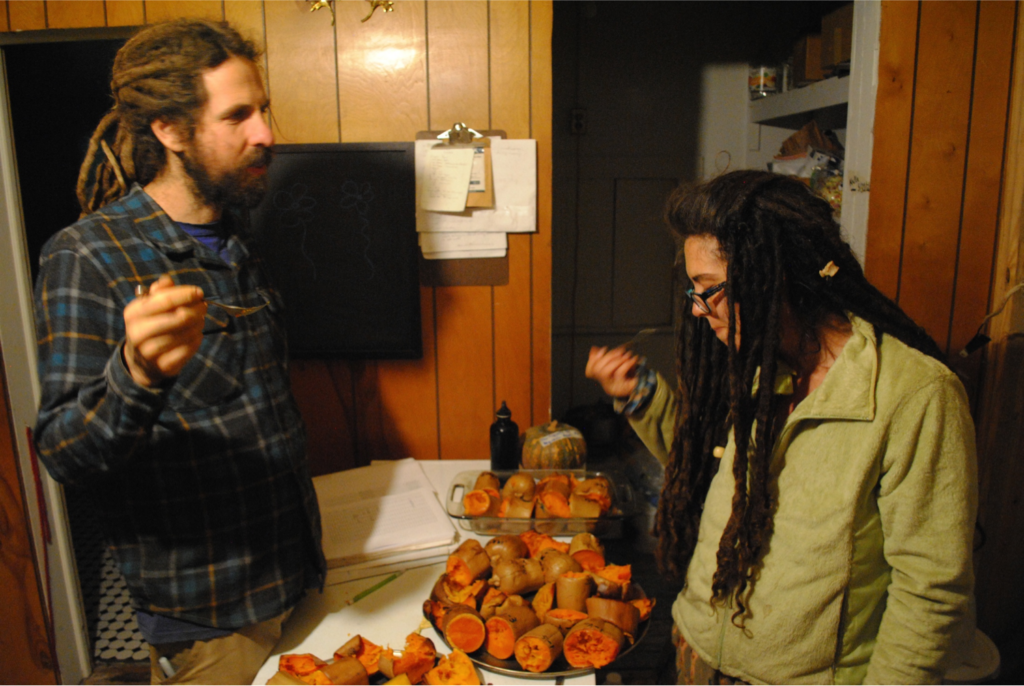
In the Chinese Tropical Pumpkin selection project we also found significant variation between plants. We recorded DM resistance and yield data for all 39 plants in the field. Based on this information, we selected 16 plants to also evaluate for eating quality (brix, dry matter and flavor tests). See the attached data spreadsheet for results. Chinese-Tropical-Selection-Project-Data
Three different seedstocks were used in the planting, all grown at Twin Oaks in 2014 and 2015. We found that the 2014 seedstock produced most of the best plants, and that the ‘15M’ seedstock produced no desirable plants.
Flavor of the best selections was outstanding, with a richness and nuttiness that is usually unseen in C. moschata species varieties. However, at a public taste testing in January (at the Virginia Association for Biological Farming conference), we noticed that eating quality had decreased and that there were some undesirable flavors present. This, along with problems keeping fruits in storage, indicates that Chinese Tropical Pumpkin is not good for long keeping and should be used within 8-10 weeks of harvest.
We found 9 plants with a good combination of yield, DMR foliage, and eating quality (median brix over 11.5, dry matter over 18, flavor of hazelnuts). We found four standouts with yields over 70 pounds per plant, good DMR and excellent eating quality.
Chinese Tropical Pumpkin

The Seminole Pumpkin selection project was impacted by bacterial wilt in addition to the downy mildew. Plants were rated in the field for DM and BW, and yield was measured. Based on this information, the best 31 (out of 42) plants were further evaluated for eating quality (including through brix and dry matter tests).
Of these, we identified 9 that had good brix and dry matter ratings, that passed taste screenings, and that had low levels of bacterial wilt and DM. We are using these in a 2017 seed production planting.
One drawback of Seminole Pumpkin is its large seed cavity size. We did not find variation in seed cavity size, so were unable to select for this trait.
See the attached data spreadsheet for results.Seminole-Selection-Project-CWSG-2016
Seminole Pumpkin in December
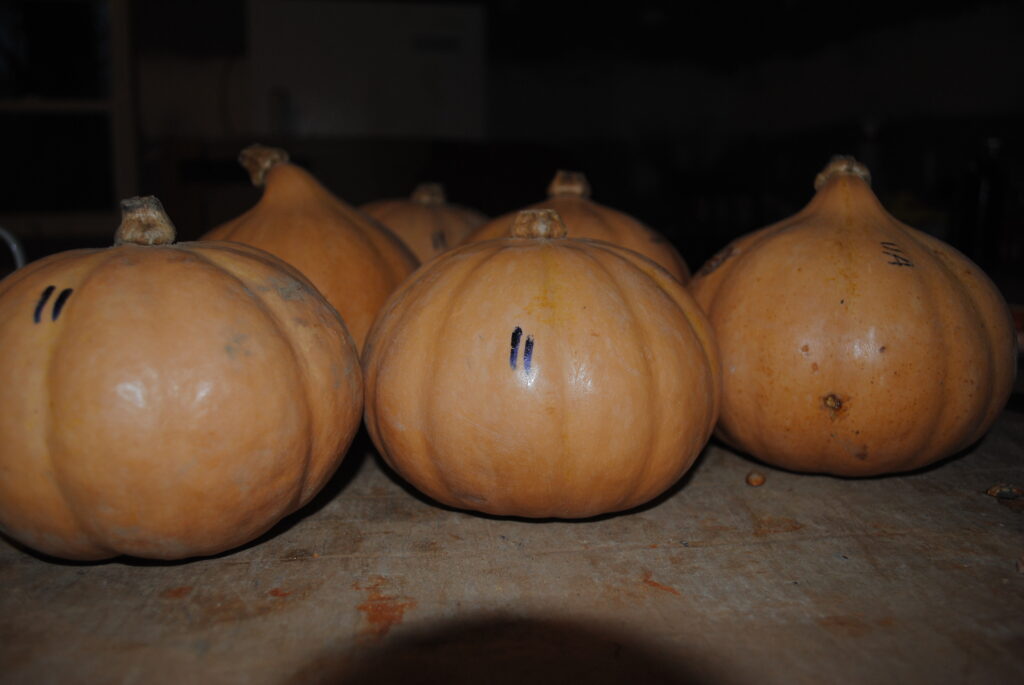
Dry Matter Testing (weighing out pieces and putting on dehydrator screens)
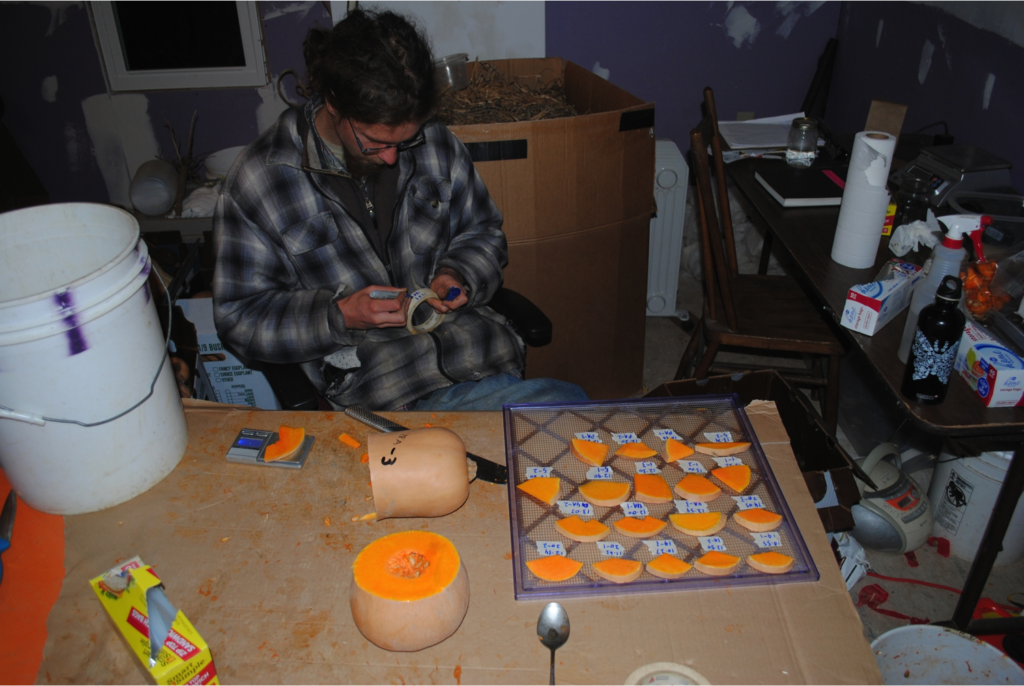
In the variety trial, we found that
- Waltham has worse downy mildew resistance than any other squash, including other commercial butternuts Bugle, JWS 6823 and Narragansett.
- Seminole Pumpkin had bad bacterial wilt. It was the first time we had seen it to this extent. Seminole was the only variety that got BW.
- Seminole-Waltham had a lot of variation in eating quality. Early lines had variation within each line; later lines had variation between lines.
- Chinese Tropical Pumpkin had generally good results but also issues of variability. This conforms to what we found in the Chinese Tropical Pumpkin selection project.
- Seminole-Waltham had better DM resistance than the commercial butternut lines, but the commercial butternuts (excepting some of the Waltham) had better average brix and dry matter, as tested in mid December.
- The commercial butternuts are shorter vined than most other entries, including Seminole-Waltham. This makes it hard to compare yield. To address this we measured approximate area of each plot, and calculated yield per square foot. The Seminole-Waltham lines had higher yield per plant than the commercial butternuts, but comparable yield per sq. foot.
- Many of the Seminole-Waltham lines used were self-pollinated in 2015, which could have adversely affected their vigor compared to open-crossed seed.
- The Seminole-Waltham lines tended to have better keeping quality than the commercial butternut varieties, and had a high percentage of marketable fruit.
- Some varieties had a problem with Black Rot, especially Bellevue Butternut and Can Tho Tourist. Dr. Michael Mazourek of Cornell University has recommended to us that we use a hydrogen peroxide seed treatment to solve this problem in the future.
- We did not record yield for one of the Bellevue Butternut entries due to an error in harvesting. Many of the fruits were not fully mature, indicating that this variety could benefit from an earlier planting date and longer season.
- The only clear new standout seedstock was a cross between Thai Pumpkin 45 and Pequenia Asar (Spanish Butternut).
- Cuban Neck Pumpkin did notably worse than in 2014 and worse than expected. This could be due to genetic narrowing that occurred because we used seed that was self-pollinated in 2015.
- JWS 6823 usually had off flavors to our taste, and Bugle and Narragansett did as well but to a lesser extent. Waltham and Seminole-Waltham had only occasional off flavors.
- See attached data spreadsheet for complete variety trial results:Winter-Squash-Variety-Trial-2016-CWSG
September 20th Field Day in Winter Squash Trial

The Cuban Neck Pumpkin selection project had problems with vine borers that killed many of the plants early on. We had not experienced vine borers in C. moschata squash, and were not expecting this.
The planting was also nonirrigated, and DM was more severe and came earlier here than in other project locations.
In addition, because we used selfed seed from 2015, there may have been an excessive degree of genetic narrowing that affected plant vigor in the 2016 planting.
As a result of all these stresses, few plants survived to make mature fruit. However, we were able to document variation in DM resistance, and to save seed from the plants that did produce fruit. In the future we will likely go back to working with an earlier, less selected seedstock, in addition to using the best seeds from 2016.
See attached data sheet for more information: Cuban-Neck-Pumpkin-Data-CWSG-2016. Note that VB = Vine Borer, and that DM = Downy Mildew, which is rated on a scale of 0-9. Zero indicates no infection and 9 indicates the most severe infection.
Cuban Neck Pumpkin
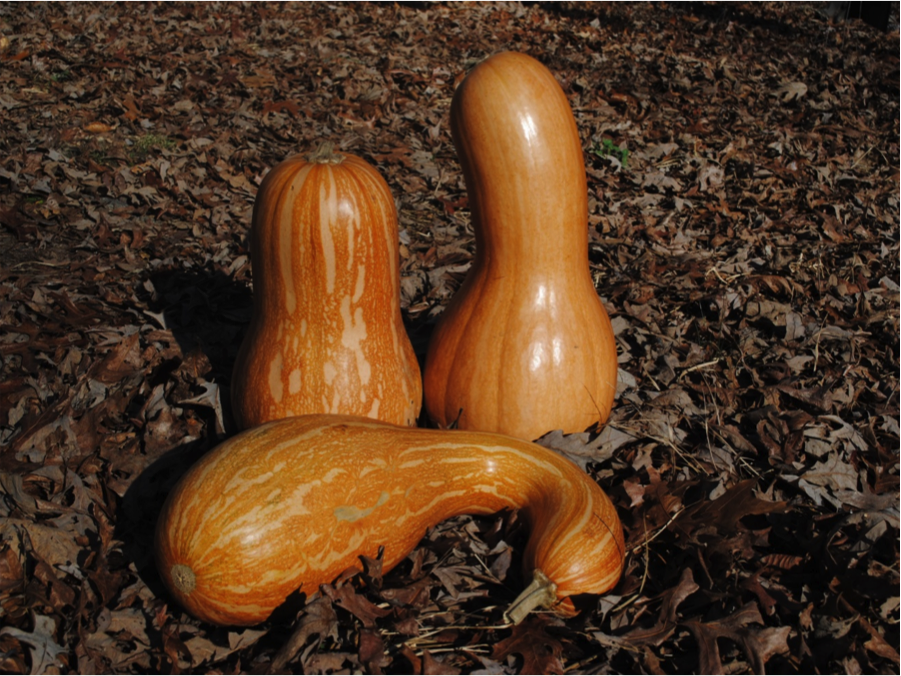
Educational & Outreach Activities
Participation Summary:
Edmund Frost presented about this work at the 2017 Virginia Association for Biological Farming conference in January, and at the 2017 Carolina Farm Stewards Association Organic Commodities and Livestock conference in March. The slideshow from the VABF conference is posted at commonwealthseeds.com/research. The final project report will be linked from there as well. At the VABF conference we conducted a public tasting in conjunction with the workshop. About 35 people attended. See attached data sheet for results. VABF-Squash-Tasting-Data
Taste Testing at VABF Conference, January 2017

In addition, Sycamore Farm hosted a winter squash field day on September 20th, where participants looked at the variety trial, the Seminole Pumpkin selection project and the Semionole-Waltham breeding project. About 15 people attended, including local farmers and extension agents. Mark Schonbeck, who works on national agriculture policy and with VABF, and Tony Kleese, former director of CFSA and Southeast representative for Organic Seed Alliance also came to the event.
Project Outcomes
Through extensive investigation and data collection, we made significant progress with two selection projects (Seminole Pumpkin and Chinese Tropical Pumpkin) and one breeding project (Seminole-Waltham).
We harvested self-pollinated and open-crossed seed from all of the best plants in the Seminole-Waltham breeding project, and self-pollinated seed from all of the best plants in the Seminole Pumpkin selection project, that we will use in our future work.
In the Chinese Tropical Pumpkin project, we harvested self-pollinated and open-crossed seed from the best selections. Unfortunately, the selfed seed from all but one of these selections (plant 5) was ruined by rodents. It is possible that we will go back to the 2014 seedstock, which our research showed was superior to the two 2015 seedstocks we used, in addition to working with open crossed seed from the best 2016 selections and with selfed seed from plant 5.
Potential Contributions
Advancing the Seminole-Waltham breeding project brings us a step closer to completing and releasing a downy mildew resistant butternut appropriate for growers in the Southeast and mid-Atlantic regions. We demonstrated its DM resistance in the variety trial (compared to several commercial butternuts), and demonstrated that there is sufficient variability in eating quality and yield from which to select plants that have high yield and excellent eating quality. Common Wealth Seed Growers is currently selling F6 Seminole-Waltham seed, which is sufficiently selected for the needs of many market growers. In addition, the Bauta Initiative in Ontario is now beginning work with our Seminole-Waltham F6 seeds to adapt them to more northern conditions. Large-scale producers in the Southeast (including squash processors) have expressed interest in the seedstock and are trialing it in 2017. When the Seminole-Waltham breeding project is complete, the variety will be named ‘South Anna Butternut,’ after the river that runs past Twin Oaks Community in Louisa County, Virginia.
The Seminole Pumpkin selection project will result in improved Seminole Pumpkin seeds that will be available through CWSG in 2018.
The Chinese Tropical Pumpkin selection project has already resulted in improved seed (open-crossed seed from the best 2016 selections) that is commercially available through CWSG.
The methods we used in our breeding, selection and trialing projects demonstrate an effective model for on-farm plant breeding in our region. We hope that it will inspire others to start similar projects. We hope that the data and discussion from the variety trial will be helpful in setting up future winter squash research projects in the Southeast.
Future Recommendations
The progress we made in 2016 should be viewed as one step in the longer processes of breeding, researching and selecting quality winter squash for our region.
We intend to continue the breeding work with Seminole-Waltham using the best selections from 2016. Currently we have selfed seed of the best 6 selections growing in a winter nursery in Florida. These will be crossed to each other, and the progeny will be tested in blocks this summer. We expect the variety (which will be called South Anna Butternut, named after a river in Louisa County, Virginia) to be ready by the end of 2018 or 2019.
In the future, a variety trial with large block entries would help eliminate the difficulty of comparing short vined and long vined varieties, and better replicate field conditions (where plants are not intensively trained). Trial blocks that have multiple rows, spaced according to vining type, could accomplish these goals. However, winter squash is so space intensive that the resources needed to do such a trial could be prohibitive. The number of entries would probably need to be very limited. The small, single-row block method we used in our 2016 trial is likely preferable for initial screenings.
Funding for farmer-led breeding and research projects is an effective (and cost-effective) way to accomplish goals of improving availability of seedstocks appropriate to regional conditions, and to organic management. We recommend that more farmers become involved in and seek funding for this work. More available funding, education and programming with these goals in mind would also be quite helpful.